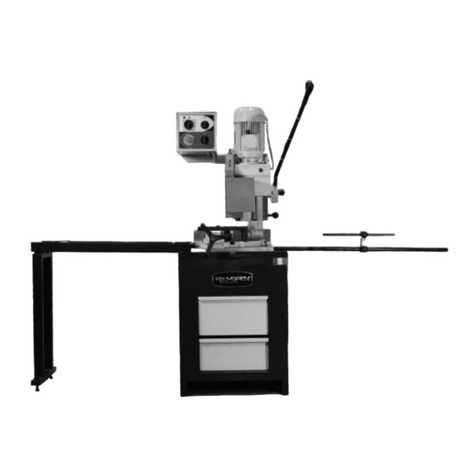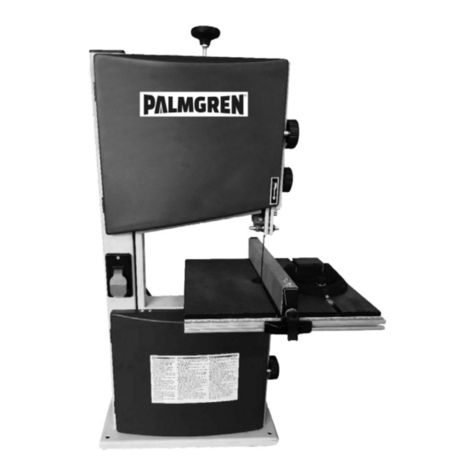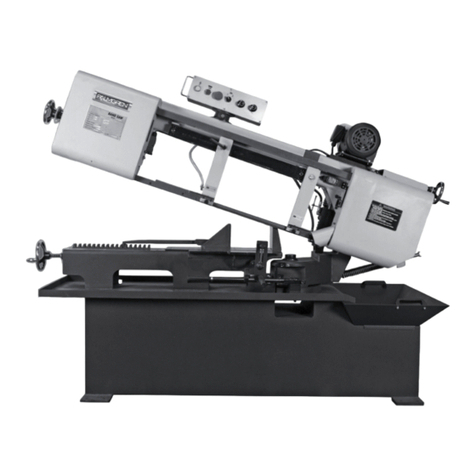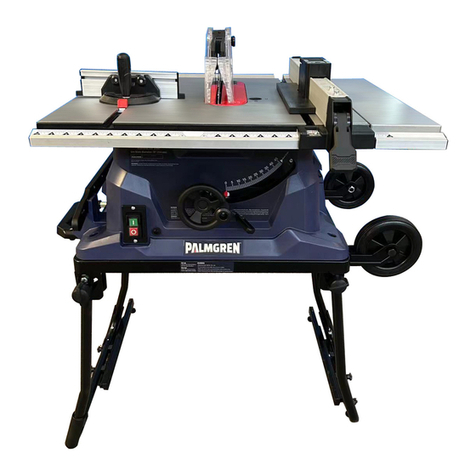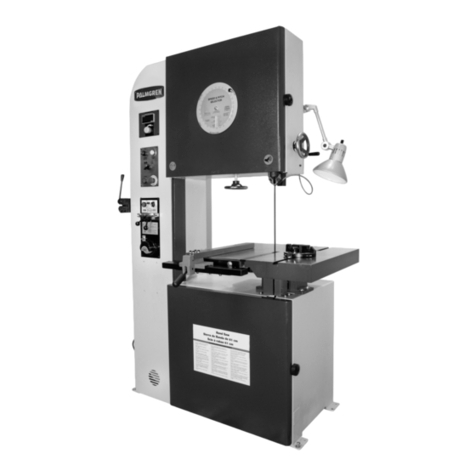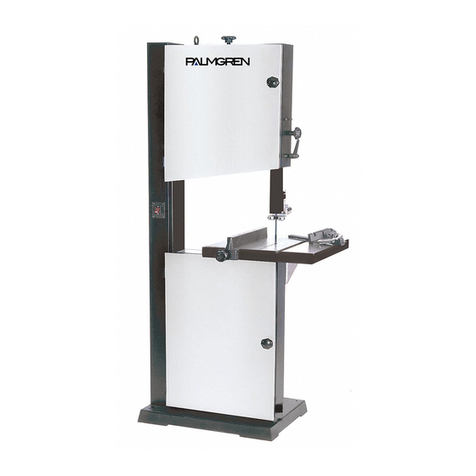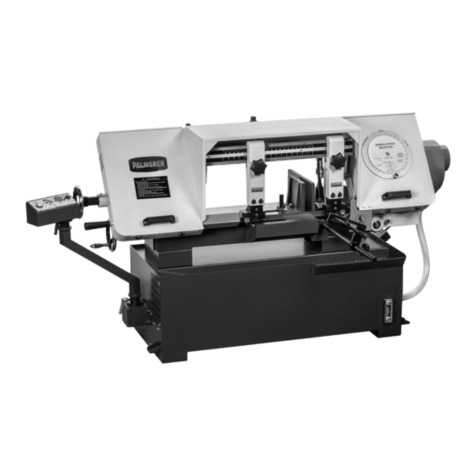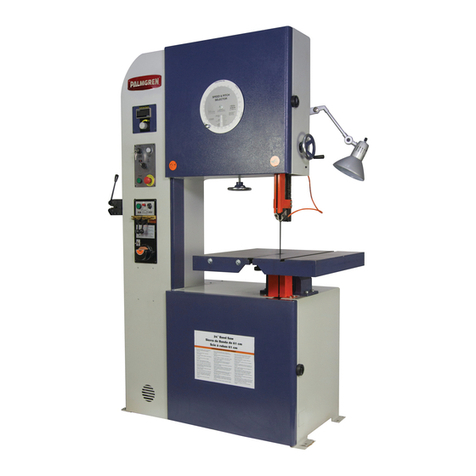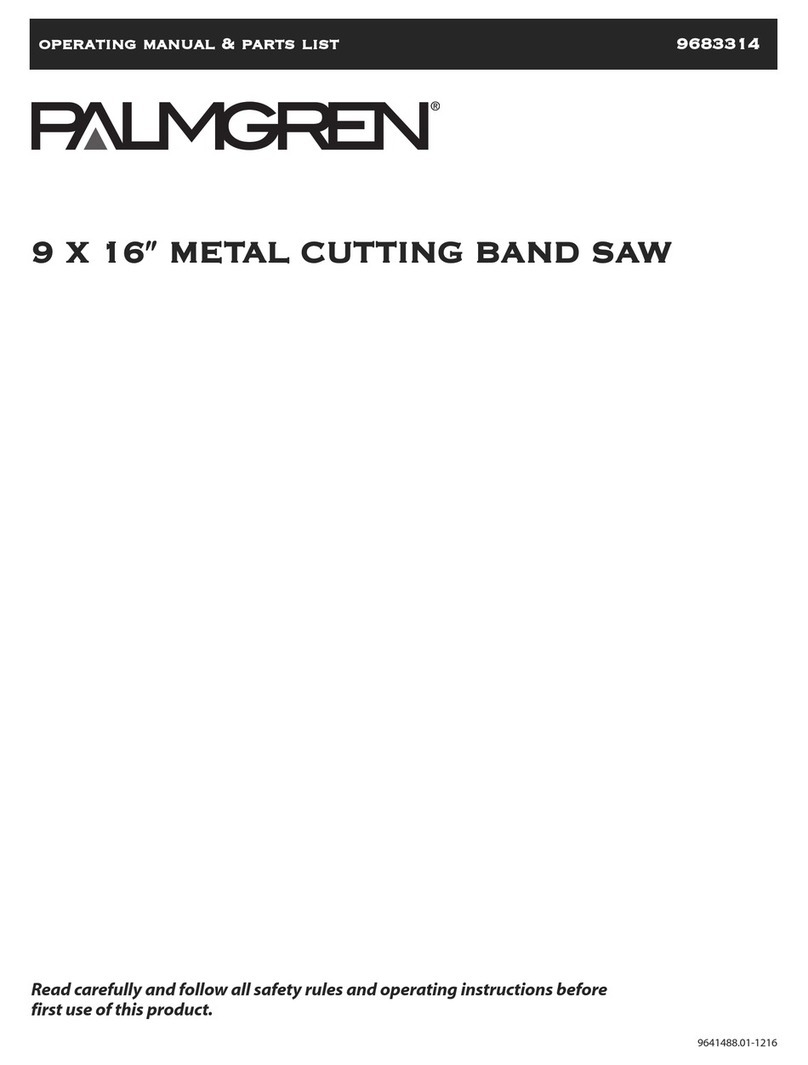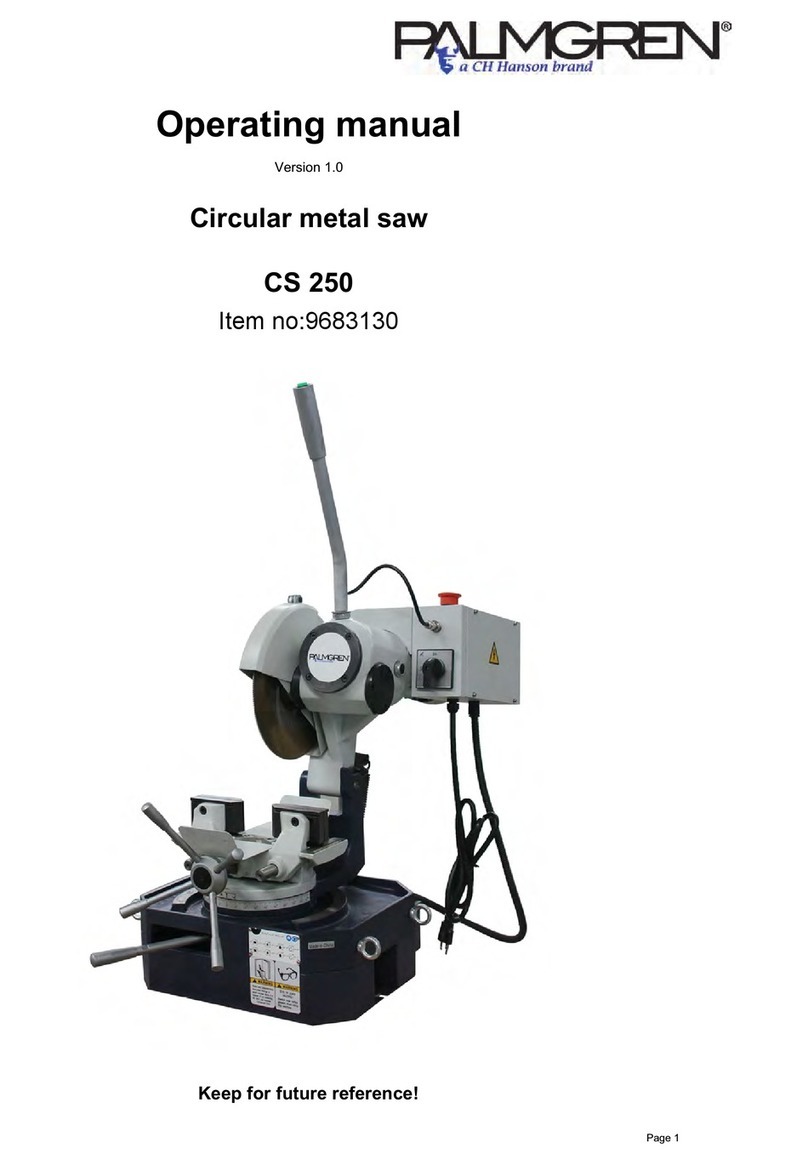DDEESSCCRRIIPPTTIIOONN
The Palmgren 16”Tilting Arm Scroll Saw features aluminum frame
construction, built-in dust collection and a constant power
mechanical variable speed control system. It is designed for cut-
ting hard and soft woods, as well as nonferrous metals and plastics.
Arm of the saw tilts from 90° to 45° while the table remains in hori-
zontal position for straight line feeding of the material.The built-in
motor driven, dust collection system helps to keep the workpiece
clean from both above and below the worksurface. Sawdust is
deposited into a detachable 30 micron filter bag for convenient
disposal. A convenient quick tensioning mechanism makes blade
changing quick and easy.
UUNNPPAACCKKIINNGG
Check for shipping damage. If damage has occurred, a claim must
be filed with carrier. Check for completeness.Immediately report
missing parts to dealer.
The scroll saw comes assembled as one unit.Additional parts
which need to be fastened to the saw should be located and
accounted for before assembling:
A Scroll Saw
B Dust Bag
C Dust Chute
D Clamp
IMPORTANT: Table is coated with a protectant.To ensure proper
fit and operation, remove coating.Coating is easily removed with
mild solvents, such as mineral spirits, and a soft cloth. Avoid getting
solution on paint or any of the rubber or plastic parts. Solvents
may deteriorate these finishes. Use soap and water on paint, plastic
or rubber components. After cleaning, cover all exposed surfaces
with a light coating of oil. Paste wax is recommended for table top.
WARNING: Never use highly volatile solvents.Non-flammable
solvents are recommended to avoid possible fire hazard.
SPECIFICATIONS
Depth of throat . . . . . . . . . . . . . . . . . . . . . . . . . . . . . . . . . . . . . . . . . . . . . .163/4”
Maximum thickness of cut at 90° . . . . . . . . . . . . . . . . . . . . . . . . . . . . . . . .2”
Maximum thickness of cut at 45° . . . . . . . . . . . . . . . . . . . . . . . . . . . . . .11/4”
Table size . . . . . . . . . . . . . . . . . . . . . . . . . . . . . . . . . . . . . . . . . . . . . . .121/2x 13”
Arm tilt . . . . . . . . . . . . . . . . . . . . . . . . . . . . . . . . . . . . . . . . . . . . . . . . .90° to 45°
Blade length (pin type) . . . . . . . . . . . . . . . . . . . . . . . . . . . . . . . . . . . . . . . . .5”
Blade speed (strokes/minute) . . . . . . . . . . . . . . . . . . . . . . . . . . . .300-1400
Stroke length . . . . . . . . . . . . . . . . . . . . . . . . . . . . . . . . . . . . . . . . . . . . . . . . . .3/4”
Overall dimensions (D x W x H) . . . . . . . . . . . . . . . . . . . . . . .30 x 14 x 18”
Weight . . . . . . . . . . . . . . . . . . . . . . . . . . . . . . . . . . . . . . . . . . . . . . . . . . . . .76 lbs
Dust collection port . . . . . . . . . . . . . . . . . . . . . . . . . . . . . . . . . . . . . . . . . .21/2”
SSAAFFEETTYYRRUULLEESS
WARNING: For your own safety, read all of the instructions and
precautions before operating tool.
CAUTION: Always follow proper operating procedures as defined
in this manual – even if you are familiar with use of this or similar
tools. Remember that being careless for even a fraction of a second
can result in severe personal injury.
BE PREPARED FOR JOB
•Wear proper apparel. Do not wear loose clothing, gloves, neck-
ties, rings, bracelets or other jewelry which may get caught in
moving parts of machine.
•Wear protective hair covering to contain long hair.
•Wear safety shoes with non-slip soles.
•Wear safety glasses complying with United States ANSI Z87.1.
Everyday glasses have only impact resistant lenses.They are
NOT safety glasses.
•Wear face mask or dust mask if operation is dusty.
•Be alert and think clearly.Never operate power tools when tired,
intoxicated or when taking medications that cause drowsiness.
PREPARE WORK AREA FOR JOB
•Keep work area clean. Cluttered work areas invite accidents.
•Do not use power tools in dangerous environments. Do not use
power tools in damp or wet locations. Do not expose power
tools to rain.
•Work area should be properly lighted.
•Proper electrical receptacle should be available for tool.Three-
prong plug should be plugged directly into properly grounded,
three-prong receptacle.
•Extension cords should have a grounding prong and the three
wires of the extension cord should be of the correct gauge.
•Keep visitors at a safe distance from work area.
•Keep children out of workplace. Make workshop childproof. Use
padlocks, master switches or remove switch keys to prevent
any unintentional use of power tools.
TOOL SHOULD BE MAINTAINED
•Always unplug tool prior to inspection.
•Consult manual for specific maintaining and adjusting
procedures.
•Keep tool lubricated and clean for safest operation.
•Remove adjusting tools. Form habit of checking to see that
adjusting tools are removed before switching machine on.
•Keep all parts in working order. Check to determine that the
guard or other parts will operate properly and perform their
intended function.
•Check for damaged parts. Check for alignment of moving parts,
binding, breakage, mounting and any other condition that may
affect a tool’s operation.
•A guard or other part that is damaged should be properly
repaired or replaced. Do not perform makeshift repairs. (Use
parts list provided to order replacement parts.)
2
Palmgren Operator’s Manual & Parts List 83116
Figure 1 – Unpacking
D
B
C
A
